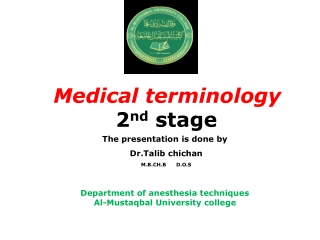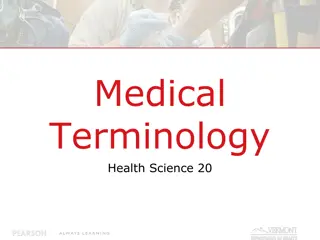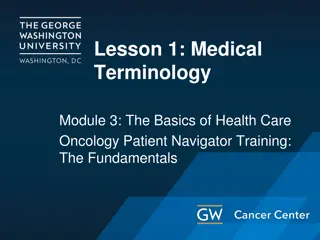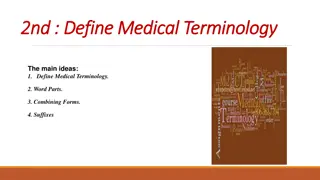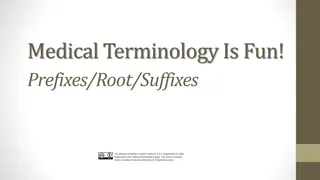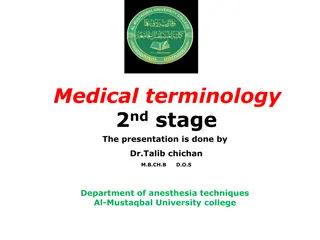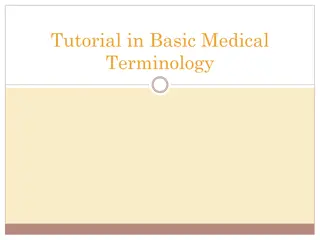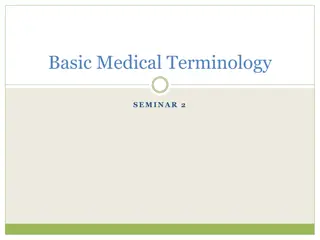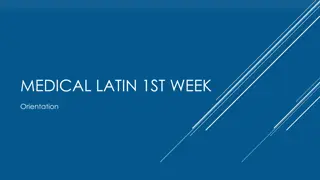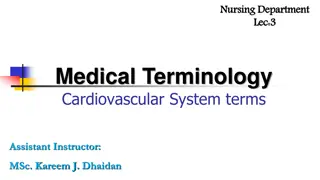Understanding Medical Terminology: Key Components and Definitions
Medical terminology is essential for effective communication in healthcare. It consists of prefixes, stems, and suffixes that help convey precise meanings. Understanding these components is crucial for healthcare professionals to interpret medical records, communicate accurately, and ensure patient safety. By breaking down medical terms and grasping the basics of prefixes, stems, and suffixes, one can navigate the complexities of medical language with confidence.
Uploaded on Oct 11, 2024 | 0 Views
Download Presentation

Please find below an Image/Link to download the presentation.
The content on the website is provided AS IS for your information and personal use only. It may not be sold, licensed, or shared on other websites without obtaining consent from the author. Download presentation by click this link. If you encounter any issues during the download, it is possible that the publisher has removed the file from their server.
E N D
Presentation Transcript
Introduction Introduction Medical Terminology Medical Terminology Kareem Jebure Dhaidan Lecturer Assistant
Define Medical Terminology: Medical terminology is the professional language of those who are directly or indirectly engaged in the art of healing. You will need to know medical terms in order to read a medical record, to complete forms, to decipher a physician's handwriting, and to communicate with others in the hospital in a professional manner.
Another Define Medical terminology is a special vocabulary used by health care professionals for effective and accurate communication. Because it is based mainly on Greek and Latin words, medical terminology is consistent and uniform throughout the world.
Build of Medical terminology All medical terms can be broken down into word parts. The three word parts that you will be concerned with are the prefix, the stem (root), and the suffix. Usually, only two of these parts are present in a medical term. The word parts, then, of a medical term may include the _________, the stem, and the suffix.
Stem Stem The stem is the part of the word which gives the basic meaning to the term. The part of the word, "epigastric" which gives the basic meaning to the word is "gastre." Therefore, "gastre" is considered to be the stem.
Prefix Prefix The part of the word which comes before the stem and modifies or augments the meaning of the stem is called the prefix. In the word " epigastric," gastre" is the stem and "basket" is the prefix
Sufix The part of the word which comes after the stem and modifies or augments the meaning of the root word is called the suffix. In the term "epigastric," "gastre is the stem and "ic" is the suffix.
Combining Forms Combining Forms When a suffix beginning with a consonant is added to a root, a vowel (usually an o) is inserted between the root and the suffix to aid in pronunciation. A combining vowel may be added between a root and a suffix.
Example Thus, when the suffix logy, meaning study of, is added to the root neur, meaning nerve or nervous system, a combining vowel is added: neur + o + logy = neurology (study of the nervous system)
Note Note A combining vowel usually is not used if the ending begins with a vowel. The root neur is combined with the suffix -itis, meaning inflammation of, in this way: neur + itis = neuritis (inflammation of a nerve) There are some exceptions to this rule, particularly when pronunciation or meaning is affected.


